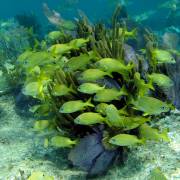
Blue Hole
Lighthouse Reef, Belize
Ambiance Deep Reef Wall
The Great Blue Hole is a large underwater sinkhole off the coast of Belize. It lies near the center of Lighthouse Reef, a small atoll 70 kilometres (43 mi) from the mainland and Belize City. The hole is circular in shape, over 300 metres (984 ft) across and 124 metres (407 ft) deep. It has formed during several episodes of Quaternary glaciation when sea levels were much lower. As the ocean began to rise again, the caves were flooded. The Great Blue Hole is a part of the larger Belize Barrier Reef Reserve System, a World Heritage Site of the UNESCO.
This site was made famous by Jacques-Yves Cousteau, who declared it one of the top ten scuba diving sites in the world. In 1971, he brought his ship, the Calypso, to the hole to chart its depths. Investigations by this expedition confirmed the hole's origin as typical karst limestone formations, formed before rises in sea level in at least four stages, leaving ledges at depths of 21, 49 and 91 meters (69, 161 and 299 ft).
This is a popular spot amongst recreational scuba divers, who are lured by the opportunity to dive in crystal-clear water and meet several species of fish, including giant groupers, nurse sharks and several types of reef sharks such as the Caribbean reef shark and the Blacktip shark. Other species of sharks, like the bull shark and hammerheads, have been reported there, but are not regular sightings. Usually, dive trips to the Great Blue Hole are full-day trips, which include one dive in the Blue Hole and two further dives in nearby reefs. Recently diving is also offered from the island Long Caye in the Lighthouse Reef only a couple of miles away from the Great Blue Hole. They offer 2 dives in the Blue Hole: North side and South side.
Visibility can be 200 feet after the very noticeable thermocline.









Reviews (2)
Have you been in Blue Hole? Write a review: